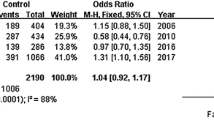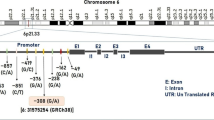Abstract
Migraine is a common neurological condition with a complex mode of inheritance. Steroid hormones have long been implicated in migraine, although their role remains unclear. Our investigation considered that genes involved in hormonal pathways may play a role in migraine susceptibility. We therefore investigated the androgen receptor (AR) CAG repeat, and the progesterone receptor (PR) PROGINS insert by cross-sectional association analysis. The results showed no association with the AR CAG repeat in our study group of 275 migraineurs and 275 unrelated controls. Results of the PR PROGINS analysis showed a significant difference in the same cohort, and in an independent follow-up study population of 300 migraineurs and 300 unrelated controls. Analysis of the genotypic risk groups of both populations together indicated that individuals who carried the PROGINS insert were 1.8 times more likely to suffer migraine. Interaction analysis of the PROGINS variant with our previously reported associated ESR1 594A variant showed that individuals who possessed at least one copy of both risk alleles were 3.2 times more likely to suffer migraine. Hence, variants of these steroid hormone receptor genes appear to act synergistically to increase the risk of migraine by a factor of three.

Similar content being viewed by others
References
Rasmussen BK (1999) Epidemiology and socio-economic impact of headache. Cephalalgia 19 [Suppl] 25:20–23
Ducros A, Tournier-Lasserve E, Bousser MG (2002) The genetics of migraine. Lancet Neurol 1:285–293
Headache classification committee for the International Headache Society (2004) Classification and diagnostic criteria for headache disorders, cranial neuralgias and facial pain, 2nd edn. Cephalgia 24 [Suppl 1]:1–60
Headache classification committee for the International Headache Society (1988) Classification and diagnostic criteria for headache disorders, cranial neuralgias and facial pain, 1st edn. Cephalgia 8 [Suppl 7]:1–96
Nyholt DR, Gillespie NG, Heath AC, et al (2004) Latent class and genetic analysis does not support migraine with aura and migraine without aura as separate entities. Genet Epidemiol 26:231–244
Lea RA, Dohy A, Jordan K, et al (2000) Evidence for allelic association of the dopamine beta-hydroxylase gene (DBH) with susceptibility to typical migraine. Neurogenetics 3:35–40
Peroutka SJ (2002) Sympathetic look at genetic basis of migraine. Headache 42:378–381
Couturier EG, Bomhof MA, Neven AK, et al (2003) Menstrual migraine in a representative Dutch population sample: prevalence, disability and treatment. Cephalalgia 23:302–308
MacGregor EA, Chia H, Vohrah RC, et al (1990) Migraine and menstruation: a pilot study. Cephalalgia 10:305–310
MacGregor EA (1996) “Menstrual” migraine: towards a definition. Cephalalgia 16:11–21
Silberstein SD, Merriam GR (2000) Physiology of the menstrual cycle. Cephalalgia 20:148–154
Epstein MT, Hockaday JM, Hockaday TD (1975) Migraine and reporoductive hormones throughout the menstrual cycle. Lancet 1:543–548
Colson NJ, Lea RA, Quinlan S, et al (2004) The estrogen receptor 1 G594A polymorphism is associated with migraine susceptibility in two independent case/control groups. Neurogenetics 5:129–133
National Centre for Biotechnology Information,http://www.ncbi.nlm.nih.gov/
Sleddens HF, Oostra BA, Brinkmann AO, et al (1992) Trinucleotide repeat polymorphism in the androgen receptor gene (AR). Nucleic Acids Res 20:1427
Westberg L, Baghaei F, Rosmond R, et al (2001) Polymorphisms of the androgen receptor gene and the estrogen receptor beta gene are associated with androgen levels in women. J Clin Endocrinol Metab 86:2562–2568
Krithivas K, Yurgalevitch SM, Mohr BA, et al (1999) Evidence that the CAG repeat in the androgen receptor gene is associated with the age-related decline in serum androgen levels in men. J Endocrinol 162:137–142
Chamberlain NL, Driver ED, Miesfeld RL (1994) The length and location of CAG trinucleotide repeats in the androgen receptor N-terminal domain affect transactivation function. Nucleic Acids Res 22:3181–3186
Yong EL, Ghadessy F, Wang Q, et al (1998) Androgen receptor transactivation domain and control of spermatogenesis. Rev Reprod 3:141–144
Zitzmann M, Brune M, Kornmann B, et al (2001) The CAG repeat polymorphism in the AR gene affects high density lipoprotein cholesterol and arterial vasoreactivity. J Clin Endocrinol Metab 86:4867–4873
Bouchard P (1999) Progesterone and the progesterone receptor. J Reprod Med 44:153–157
Bethea CL, Lu NZ, Gundlah C, et al (2002) Diverse actions of ovarian steroids in the serotonin neural system. Front Neuroendocrinol 23:41–100
Cenni B, Picard D (1999) Ligand-independent activation of steroid receptors: new roles for old players. Trends Endocrinol Metab 10:41–46
Rowe SM, Coughlan SJ, McKenna NJ, et al (1995) Ovarian carcinoma-associated Taq I restriction fragment length polymorphism in intron G of the progesterone receptor gene is due to an Alu sequence insertion. Cancer Res 55:2743–2745
Tong D, Fabjani G, Heinze G, et al (2001) Analysis of the human progesterone receptor gene polymorphism progins in Austrian ovarian carcinoma patients. Int J Cancer 95:394–397
Runnebaum IB, Wang-Gohrke S, Vesprini D, et al (2001) Progesterone receptor variant increases ovarian cancer risk in BRCA 1 and BRCA 2 mutation carriers who were never exposed to oral contraceptives. Pharmacogenetics 11:635–638
Donaldson CJ, Crapanzano JP, Watson JC, et al (2002) PROGINS Alu insertion and human genomic diversity. Mutat Res 501:137–141
Lea RA, Curtain RP, Hutchins C, et al (2001) Investigation of the CACNA 1A gene as a candidate for typical migraine susceptibility. Am J Med Genet 105:707–712
Johnson MP, Lea RA, Curtain RP, et al (2003) An investigation of the 5-HT2C receptor gene as a migraine candidate gene. Am J Med Genet 117B:86–89
Miller SA, Dykes DD, Polesky HF (1988) A simple salting out procedure for extracting DNA from human nucleated cells. Nucleic Acids Res 16:1215
Lancaster JM, Berchuck A, Carney ME, et al (1998) Progesterone receptor gene polymorphism and risk for breast and ovarian cancer. Br J Cancer 78:277
Sham P, Curtis D (1995) Monte Carlo tests for associations between disease and alleles at highly polymorphic loci. Ann Hum Genet 59:97–105
Mantel N, Haenszel W (1959) Statistical aspects of the analysis of data from retrospective studies of disease. J Natl Cancer Inst 22:719–748
Hall JM, Couse JF, Korach KS (2001) The multifaceted mechanisms of estradiol and estrogen receptor signaling. J Biol Chem 276:36869–36872
Schumacher M (1990) Rapid membrane effects of steroid hormones: an emerging concept in neuroendocrinology. Trends Neurosci 13:359–362
Tan RS, Pu SJ, Culberson JW (2004) Role of androgens in mild cognitive impairment and possible interventions during andropause. Med Hypotheses 62:14–18
Lu NZ, Bethea CL (2002) Ovarian steroid regulation of 5-HT1A receptor binding and G protein activation in female monkeys. Neuropsychopharmacology 27:12–24
Blomqvist A (2000) Sex hormones and pain: a new role for brain aromatase? J Comp Neurol 423:549–551
Kurz C, Tempfer CB, Boecskoer S, et al (2001) The PROGINS progesterone receptor gene polymorphism and idiopathic recurrent miscarriage. J Soc Gynecol Investig 8:295–298
Acknowledgements
This work was supported by funding from the National Health and Medical Research Council (NHMRC) of Australia and Griffith University. Dr Rod Lea is supported by an NHMRC C.J. Martin Fellowship. Experiments comply with the current laws in Australia.
Author information
Authors and Affiliations
Corresponding author
Rights and permissions
About this article
Cite this article
Colson, N.J., Lea, R.A., Quinlan, S. et al. Investigation of hormone receptor genes in migraine. Neurogenetics 6, 17–23 (2005). https://doi.org/10.1007/s10048-004-0205-0
Received:
Accepted:
Published:
Issue Date:
DOI: https://doi.org/10.1007/s10048-004-0205-0




